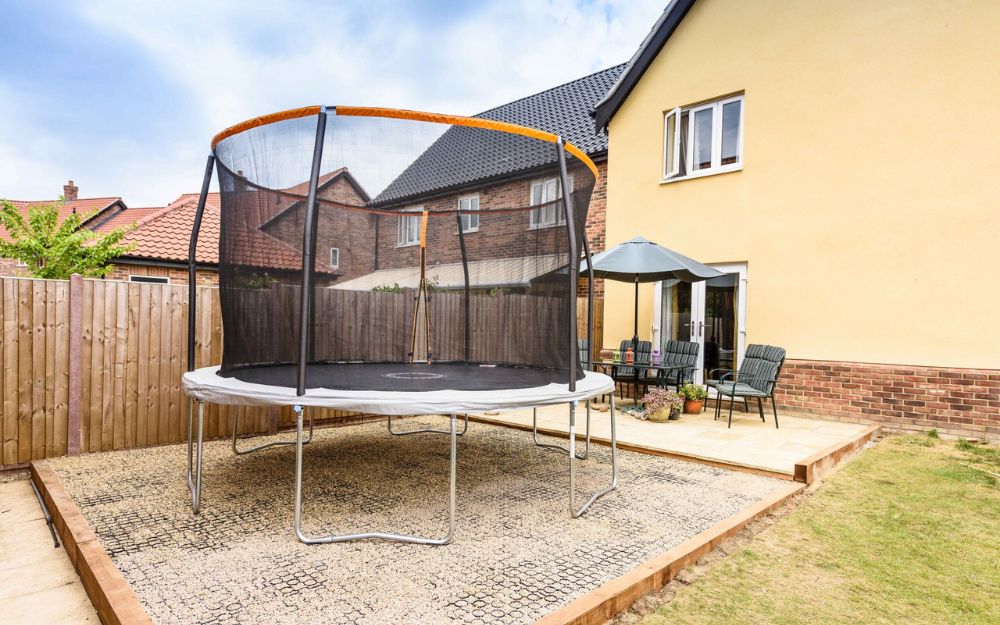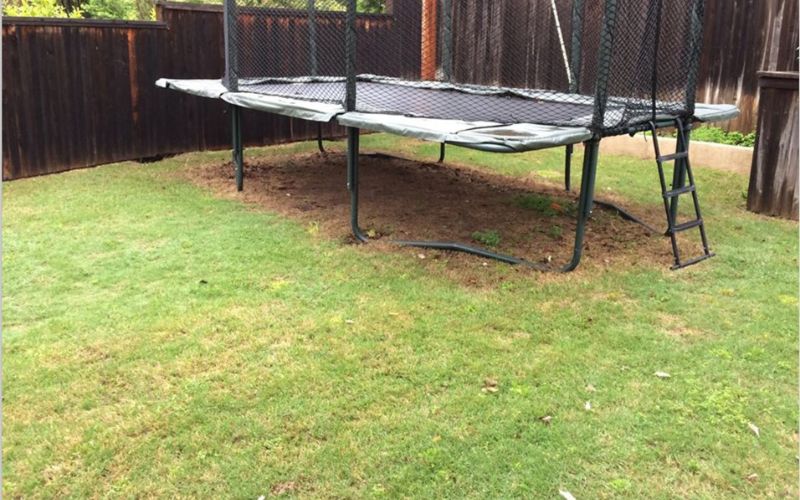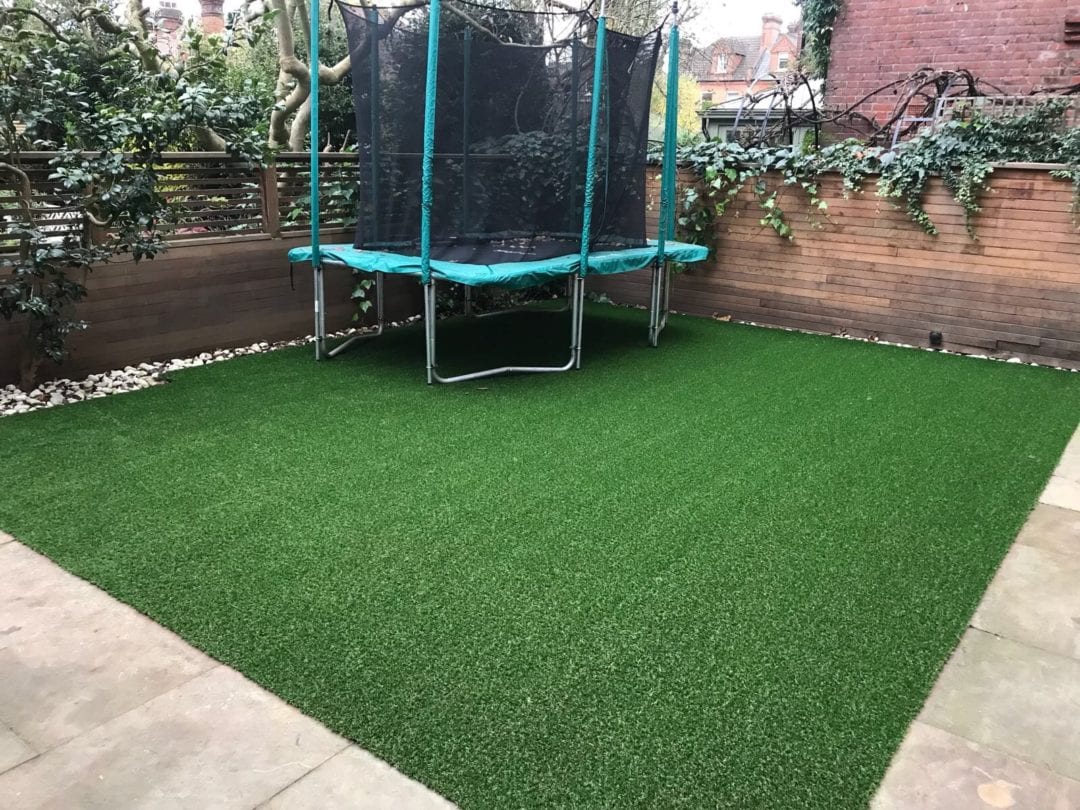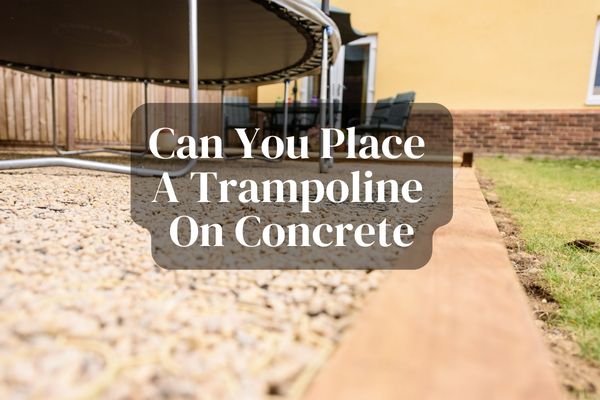Jumping equipment like a trampoline is gaining a lot of popularity nowadays. It adds to your backyard recreation and can be a good workout for health-conscious people. Imagine getting one yourself and now being left with worries about where to put it.
Is the garden surface suitable? Can you place a trampoline on concrete?
You must not put a trampoline on hard surfaces like concrete. By doing so, you are going to hamper the structural integrity of the frame and legs.
When you place a trampoline on concrete and use it, the impact force is not absorbed properly. It puts stress on the trampoline, and it might end up getting damaged soon.

In this article, we will discuss the best places for setting up trampolines and surfaces you should avoid so that you can stay away from damaging the tramp or hurting yourself. Bear with us and continue reading.
Suitable Surfaces for Setting up Trampoline
As your main concern is about where to put the trampoline, you have to be very cautious about it. A mismanaged underlying surface can put you at risk of damaging the trampoline over time. As we said, avoid hard surfaces and try for softer lands. Here are a few options for you.
Lawn Grass
Setting up a trampoline on grass is the best way to do it. Putting a trampoline on a grass plane helps to absorb the shock better and distribute it throughout the ground rather than the trampoline legs. This is the number one pick for a reason.
Keep in mind that you have to find a plain surface and something that is not sloped or bumpy. The softness of the grass helps the trampoline legs to stick better onto the surface.

One drawback is that after extensive use, the grass underneath and the soil can take some hit and might end up getting damaged. This is when you must disassemble the tramp and relocate it. Set it on a similar surface, preferably a few feet away from the previous location.
Let the surface heal under natural sunlight and allow good air circulation. You can add seeds and soil to reinvigorate the old surface. Once it is done healing, you can put the tramp on this place again.
Synthetic Grass
Don’t stress out if you don’t have a natural grass field in your backyard. You can opt to install artificial grass turfs. These are synthetic options that imitate real grass. Believe it or not, artificial grass mats can be more long-lasting than real grass planes.

Perks of having artificial grass:
- It can be placed on top of a solid concrete surface yet provide the softness of grass
- Needs next to no maintenance. You don’t need to water it, feed it, or give sunlight exposure to it like you have to do for real grass
- Acts as a protective cushioning over a hard surface. It can absorb the applied force on trampoline legs, keeping you and the trampoline safe
- The outlook is pretty striking. The greens are similar to the real ones and will enhance the beauty of your lawn
Rubber Tiles
If you want to avoid the natural green look, rubber tiles or weight-lifting mats can be good options. Their construction is rubber based, so the shock absorption is pretty decent and will protect the trampoline from slipping sideways.
And if you have a concrete floor to deal with, install rubber tiles on them and then place your trampoline above it. You might need a little maintenance, such as dusting and removing debris from the surface. Well, this maintenance can be done every month. So, relax.
Can You Place a Trampoline on Concrete? Things You Need to Avoid
We won’t recommend putting a trampoline on the concrete floor. You can do it, but the chances are high that the trampoline legs will wear out faster. Your trampoline might end up slipping from the turf and get damaged. Why take the risk anyway?
Please follow these instructions to be on the safe side:
- If you seriously want to add a trampoline to your backyard, avoid placing it on hard surfaces like cement or concrete
- Make sure the surface is level and not bumpy
- Avoid putting the tramp on any sloped area. Otherwise, you can easily fall off the trampoline due to the uneven surface. If your backyard has a rough, bumpy plane, you better level the turf first, using leveling tools
- Make sure you don’t place the trampoline in a cramped space. Avoid fitting it under trees or around swimming pools to avoid injuries. Also, keep sufficient space on each side of your trampoline. You might get knocked off the mat, so you better avoid a collision
A clearance of 1.5 meters from the trampoline edges should work
- Never enter a trampoline without a safety net. Having a safety net around the trampoline will protect you and the kids from landing on the ground.
Always Anchor Your Trampoline as a Safety Measure
Whatever you do, we would recommend you to anchor the trampoline no matter what. Even if you end up putting it on a grass surface, the legs can slide, and the tramp can move, eventually causing severe problems.
You can anchor a trampoline on various surfaces. To know how it is done, you can follow this write-up. Keep in mind that anchoring helps keep the trampoline in one place and protects the equipment from blowing away in heavy winds.
Final Thoughts
We have heard this question quite a lot, ‘can you place a trampoline on concrete?’ It’s fair for people to ask this because not everyone has a grass field on their patio or backyard.
The answer is you should avoid placing the trampoline on a hard surface like concrete. It is wise to have a soft grass field for trampolines. The grass surface and soil are known for their shock-absorbing properties.
As alternatives, you can try out synthetic tiles – or best – if you get artificial grass. Make sure your surfaces are flat and not bumpy. Once you’ve chosen your desired surface, we would request you follow the safety tips before putting your feet on the jumping mat. Have fun!
Frequently Asked Questions
What Is the Best Surface for Putting Trampolines?
A soft and level surface is ideal for holding trampolines. Grass turf is worth the hype, and we have discussed it in this article. Have a read. Rubber tiles or artificial grass are viable options, too, if you don’t have a natural grass field.
Can You Place Trampoline on Stones?
A big no-no! Trampolines should never be placed on hard planes. Avoid concrete, stones, cement, and such. Always pick soft planes for better impact absorption.
Why Do People Prefer Flat Ground for Installing Trampolines?
Even if you can manage to put a trampoline on sloped ground, why would you do that? The overall structure will be misaligned with the ground level; thus, there are chances that you may bounce off the mat and end up falling from the edge due to unevenness.
How Far Away from Objects Should a Trampoline Be Installed?
To be safe, the ideal distance from the trampoline perimeter should be 1.5 meters. This will provide enough space for you to avoid hitting other objects in case you fall.
Last Updated on August 14, 2023

